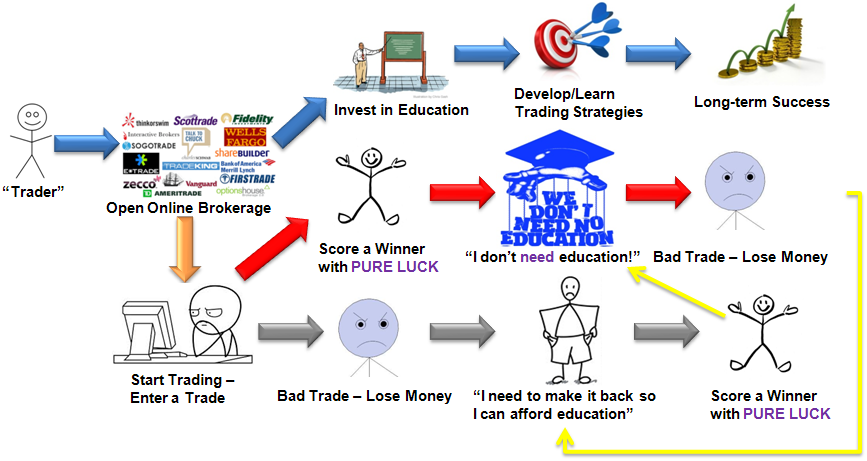https://www.stocktrader.com/free-technical-analysis-education-articles/
Search
Latest topics
Disclaimer
Information posted in this forum are entirely of the respective members' personal views. The views posted on this open online forum of contributors do not constitute a recommendation buy or sell. The site nor the connected parties will be responsible for the posts posted on the forum and will take best possible action to remove any unlawful or inappropriate posts.
All rights to articles of value authored by members posted on the forum belong to the respective authors. Re-using without the consent of the authors is prohibited. Due credit with links to original source should be given when quoting content from the forum.
This is an educational portal and not one that gives recommendations. Please obtain investment advises from a Registered Investment Advisor through a stock broker
Free Technical Analysis Education

nihal123- Top contributor

- Posts : 6327
Join date : 2014-02-24
Age : 58
Location : Waga
- Post n°1
 Free Technical Analysis Education
Free Technical Analysis Education
https://www.stocktrader.com/free-technical-analysis-education-articles/

chutiputha- Top contributor

- Posts : 1948
Join date : 2014-11-09
Age : 38
Location : SL
I would like to go further....
Charts Types....
1. Daily bar chart– This is the most widely used chart. It is constructed to show four pieces of information: opening price, closing price, high of the day, and low of the day. Looking at each day’s history, a vertical line shows the day’s range with a horizontal line pointing left to mark the opening price and a horizontal line pointing right to mark the closing price.

2. Candlestick chart – This chart presents the same data as a bar chart, but in a slightly different format. The chart has two main parts. The first is the thin line, known as the “shadow,” which shows the price range from high to low. The wider area, known as the “real body,” measures the difference between the opening price and the closing price. If the close is higher than the open, the real body is white.


chutiputha- Top contributor

- Posts : 1948
Join date : 2014-11-09
Age : 38
Location : SL

4. Point and figure –A point and figure chart is concerned only with price, not time or volume. The chart uses an X to mark increases in price and an O to mark lower prices. With this approach it is easier to spot trends and reversals. However, since time is not used as an input, P&Fs offer little guidance on how long it will take for profit objectives to be met.


chutiputha- Top contributor

- Posts : 1948
Join date : 2014-11-09
Age : 38
Location : SL
1. Gaps – Gaps occur when a price opens much higher (gap higher) or lower (gap lower) than the previous day’s close. Once a gap occurs, the new price represents an important price level. Gaps higher create support that should allow the stock to move higher and gaps lower create resistance that should pressure the stock lower. Until the gap is violated, we should assume the trend will continue in the gap’s direction. Amazon.com (AMZN) shows a gap higher on heavy volume (black arrow) that now acts as support (black line). As the stock has traded higher from that moment, it would take a close below $57.50 to indicate the bullish move is over.


chutiputha- Top contributor

- Posts : 1948
Join date : 2014-11-09
Age : 38
Location : SL
To see this pattern in action, consider the Volatility index (VIX). In October, a strong uptrend took the VIX near 80 before a sell-off. This formed the left shoulder. A rally above 80 and subsequent decline created the head. When VIX then topped out near 70, the right shoulder was formed. The breaking of the neckline (blue line) pointed to lower prices. To estimate the downside target, we use the difference between the head and the neckline.


chutiputha- Top contributor

- Posts : 1948
Join date : 2014-11-09
Age : 38
Location : SL


chutiputha- Top contributor

- Posts : 1948
Join date : 2014-11-09
Age : 38
Location : SL


chutiputha- Top contributor

- Posts : 1948
Join date : 2014-11-09
Age : 38
Location : SL


chutiputha- Top contributor

- Posts : 1948
Join date : 2014-11-09
Age : 38
Location : SL
A cup-and-handle pattern resembles the shape of a tea cup on a chart.
This is a bullish continuation pattern where the upward trend has paused, and traded down, but will continue in an upward direction upon the completion of the pattern. This pattern can range from several months to a year, but its general form remains the same.
The cup-and-handle pattern is preceded by an upward move, which stalls and sells off. The sell-off is what forms the initial part of this pattern. After the sell-off, the security will basically trade flat for an extended period of time, with no clear trend. The next part of the pattern is the upward move back towards the peak of the preceding upward move. The last part of the pattern, known as the handle, is a relatively smaller downward move before the security moves higher and continues the previous trend.


chutiputha- Top contributor

- Posts : 1948
Join date : 2014-11-09
Age : 38
Location : SL
- Post n°10
 Re: Free Technical Analysis Education
Re: Free Technical Analysis Education

1.Optimism – A positive outlook encourages us about the future, leading us to buy stocks.
2.Excitement – Having seen some of our initial ideas work, we begin considering what our market success could allow us to accomplish.
3.Thrill – At this point we investors cannot believe our success and begin to comment on how smart we are.
4.Euphoria – This marks the point of maximum financial risk. Having seen every decision result in quick, easy profits, we begin to ignore risk and expect every trade to become profitable.
5.Anxiety – For the first time the market moves against us. Having never stared at unrealized losses, we tell ourselves we are long-term investors and that all our ideas will eventually work.
6.Denial – When markets have not rebounded, yet we do not know how to respond, we begin denying either that we made poor choices or that things will not improve shortly.
7.Fear – The market realities become confusing. We believe the stocks we own will never move in our favor.
8.Desperation – Not knowing how to act, we grasp at any idea that will allow us to get back to breakeven.
9.Panic – Having exhausted all ideas, we are at a loss for what to do next.
10.Capitulation – Deciding our portfolio will never increase again, we sell all our stocks to avoid any future losses.
11.Despondency – After exiting the markets we do not want to buy stocks ever again. This often marks the moment of greatest financial opportunity.
12.Depression – Not knowing how we could be so foolish, we are left trying to understand our actions.
13.Hope – Eventually we return to the realization that markets move in cycles, and we begin looking for our next opportunity.
14.Relief – Having bought a stock that turned profitable, we renew our faith that there is a future in investing.

chutiputha- Top contributor

- Posts : 1948
Join date : 2014-11-09
Age : 38
Location : SL
- Post n°11
 Re: Free Technical Analysis Education
Re: Free Technical Analysis Education
1.Art over science – Many investment approaches require us to perform a great deal of math to generate an answer. Technical analysis does not. Looking at the same chart, many investors will derive different answers. Therefore, reading charts evolves into an art form where each analyst can provide a unique insight.
2.No need to know – As more information becomes available, people become obsessed with knowing why events occur. In the markets, we often never know. Instead of searching for the next piece of data that magically unlocks the puzzles, technicians focus on the past and interpolate how it will affect the future.
3.History repeats – A study of history shows that set patterns repeat themselves over long periods. By relying on the past to predict the future, we can take advantage of these patterns.
4.Self-fulfilling prophecy – Enough people seeing the same pattern will take actions that force the prediction to occur. While this is positive if you are on the right side of the trade, it presents a major weakness when everyone attempts to exit at the same time.
5.Momentum reverses – When a trade becomes very crowded with everyone assuming the same position, unexpected surprises can drive prices. If the exit becomes crowded, what first looked promising quickly becomes a nightmare.

chutiputha- Top contributor

- Posts : 1948
Join date : 2014-11-09
Age : 38
Location : SL
- Post n°12
 Re: Free Technical Analysis Education
Re: Free Technical Analysis Education


» CCS.N0000 ( Ceylon Cold Stores)
» Sri Lanka plans to allow tourists from August, no mandatory quarantine
» When Will It Be Safe To Invest In The Stock Market Again?
» Dividend Announcements
» MAINTENANCE NOTICE / නඩත්තු දැනුම්දීම
» ඩොලර් මිලියනයක මුදල් සම්මානයක් සහ “ෆීල්ඩ්ස් පදක්කම” පිළිගැනීම ප්රතික්ෂේප කළ ගණිතඥයා
» SEYB.N0000 (Seylan Bank PLC)
» Here's what blind prophet Baba Vanga predicted for 2016 and beyond: It's not good
» The Korean Way !
» In the Meantime Within Our Shores!
» What is Known as Dementia?
» SRI LANKA TELECOM PLC (SLTL.N0000)
» THE LANKA HOSPITALS CORPORATION PLC (LHCL.N0000)
» Equinox ( වසන්ත විෂුවය ) !
» COMB.N0000 (Commercial Bank of Ceylon PLC)
» REXP.N0000 (Richard Pieris Exports PLC)
» RICH.N0000 (Richard Pieris and Company PLC)
» Do You Have Computer Vision Syndrome?
» LAXAPANA BATTERIES PLC (LITE.N0000)
» What a Bank Run ?
» 104 Technical trading experiments by HUNTER
» GLAS.N0000 (Piramal Glass Ceylon PLC)
» Cboe Volatility Index
» AHPL.N0000
» TJL.N0000 (Tee Jey Lanka PLC.)
» CTBL.N0000 ( CEYLON TEA BROKERS PLC)
» COMMERCIAL DEVELOPMENT COMPANY PLC (COMD. N.0000))
» Bitcoin and Cryptocurrency
» CSD.N0000 (Seylan Developments PLC)
» PLC.N0000 (People's Leasing and Finance PLC)
» Bakery Products ?
» NTB.N0000 (Nations Trust Bank PLC)
» Going South
» When Seagulls Follow the Trawler
» Re-activating
» අපි තමයි හොඳටම කරේ !
» මේ අර් බුධය කිසිසේත්ම මා විසින් නිර්මාණය කල එකක් නොවේ
» SAMP.N0000 (Sampath Bank PLC)
» APLA.N0000 (ACL Plastics PLC)
» AVOID FALLING INTO ALLURING WEEKEND FAMILY PACKAGES.
» Banks, Finance & Insurance Sector Chart
» VPEL.N0000 (Vallibel Power Erathna PLC)
» DEADLY COCKTAIL OF ISLAND MENTALITY AND PARANOID PERSONALITY DISORDER MIX.
» WATA - Watawala
» KFP.N0000(Keels Food Products PLC)
» Capital Trust Broker in difficulty?
» IS PIRATING INTELLECTUAL PROPERTY A BOON OR BANE?
» What Industry Would You Choose to Focus?
» Should I Stick Around, or Should I Follow Others' Lead?